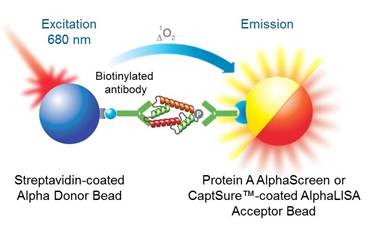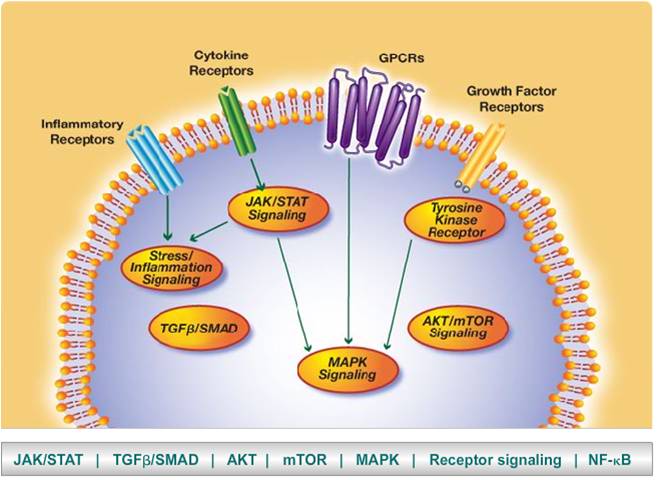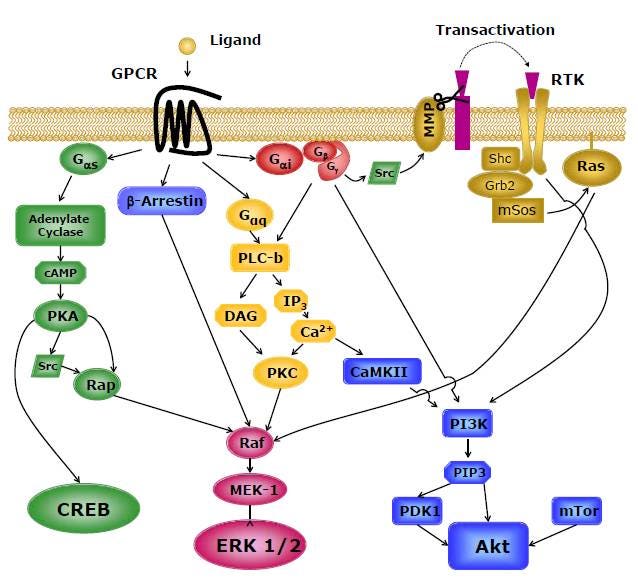
Overview
Alpha SureFire® cellular kinase assays measure endogenous levels of phosphorylated cellular proteins (the "analytes") involved in various signaling pathways. Revvity’s unique bead-based Alpha technology is highly versatile and can be used to study nearly any biological interaction using small molecules, large molecules, and binding partners of greatly disparate size. This unique technology has been combined with a new generation of cell-based, high throughput screening developed by TGR Biosciences, called SureFire®. The two technologies work together to provide a cell-based environment for assaying modulation of receptor activation and can also be used to measure responses of intracellular kinase inhibitors for drug discovery or fundamental research. For each Alpha SureFire kit, the phosphorylated protein is detected using sandwiching antibodies. One antibody is directed against a specific phospho-epitope on the analyte, while the other antibody is directed against another, non-phosphorylated, epitope on a distal part of the analyte.
Please note that some of the kits are detecting the "total" analyte content (i.e. detection of both the phosphorylated and non-phosphorylated forms of the analyte), to be used as a control or for normalization of the data acquired with the "phosphoprotein kits".

Alpha SureFire Assay Principle
In the assay, cells are treated with agents known or suspected to trigger or inhibit phosphorylation of the analyte and then lysed. The lysate is then mixed with the Alpha SureFire reagents:
In an AlphaScreen™ SureFire® assay, Donor beads are coated with streptavidin to capture a biotinylated antibody. AlphaScreen Acceptor beads are coated with Protein A to capture the second antibody (the biotinylated antibody is carefully selected so that protein A will not capture it efficiently). In the presence of phosphorylated protein, the two antibodies bring the Donor and Acceptor beads close together, generating signal. The amount of light emission is directly proportional to the amount of phosphoprotein present in the sample.
In an AlphaLISA™ SureFire® Ultra™ assay, Acceptor beads are instead coated with a proprietary CaptSure™ agent that immobilizes the second assay antibody, labeled with a CaptSure™ tag. This minimizes potential interference from spiked antibodies and also results in better sensitivity and a broader dynamic range. The emission wavelength of the AlphaLISA Acceptor beads is out of hemoglobin absorption spectrum, making it a better tool for working with tissue lysates.
Our newer AlphaLISA SureFire Ultra assay offers several advantages:
- Simplified protocols
- User-friendly reaction volumes
- Lower background signal (due to the use of CaptSure™ technology for antibody specificity)
- Higher signal-to-background
- Better sensitivity
- Compatible with the use of spike antibodies (i.e., studies using biotherapeutic antibodies, antibody blockers, etc.)
- Best format for tissue sample analysis (due to the spectrum of the AlphaLISA Acceptor beads)
|
Kit |
Kit Size |
Recommended plate format |
Final assay volume |
|---|---|---|---|
|
AlphaScreen SureFire |
500 assay points |
384-well ProxiPlate |
11 µL |
|
10,000 assay points |
384-well ProxiPlate |
11 µL |
|
|
50,000 assay points |
384-well ProxiPlate |
11 µL |
|
|
High volume (100 assay points) |
96-well 1/2 AreaPlate |
50 µL |
|
|
AlphaLISA SureFire Ultra |
500 assay points |
384-well |
20 µL |
|
10,000 assay points |
384-well |
20 µL |
|
|
50,000 assay points |
384-well |
20 µL |
|
|
High volume (100 assay points) |
96-well 1/2 AreaPlate |
60 µL |
Assay features
- Cell-based assay, demonstrated applications on recombinant cells, primary cells, stem cells and tissues
- Homogeneous (no wash) assay - mix components in well and read
- Microplate-based assay
- 96- and 384-well formats, also demonstrated use in 1536-well format
- Well-suited for quantification of compound actions, as well as HTS screening
- Alpha SureFire assays are based on Alpha assay technology.
What do I need to run this assay?
AlphaLISA SureFire Ultra Assays
Available from Revvity:
- AlphaLISA SureFire Ultra kit - contains validated antibodies for a given analyte (included in the Reaction Buffer), Donor and Acceptor beads, cell lysis buffer, activation buffer, dilution buffer, positive control lysates, and detailed protocol
- TopSeal™-A adhesive plate seal
- Microplates
- For adherent cell assays performed using a transfer step (i.e. transferring an aliquot of cell lysate to an immunoassay plate), you will need:
- A 96-well or 384-well TC-treated plate for growing and treating the cells (such as Revvity CulturPlates™ or TC-treated ViewPlates™)
- A 384-well white plate for the assay (we recommend our “OptiPlate-384, White Opaque 384-well Microplate” OptiPlate™, or our “AlphaPlate-384, Light Gray, untreated 384-well Microplate” when limiting the cross-talk signal is critical).
- For adherent cell assays performed in a single plate, you will need:
- A 384-well TC-treated plate for growing and treating the cells, followed by their lysis in the same plate, and the addition of alpha reagents (such as Revvity CulturPlates™)
- For non-adherent or suspension cell assays: you will need either a 384-well white OptiPlate or a sterile 384-well white CulturPlate, as desired. Both of these plates are also offered in 96-well format.
- For adherent cell assays performed using a transfer step (i.e. transferring an aliquot of cell lysate to an immunoassay plate), you will need:
- Plate lids (or breathable plate seal available from Nunc™)
- Cells expressing the receptor or target of interest, either endogenously expressed, or as stably transfected cells (from Revvity, or you can use your own cell line). Frozen cells (AequoZen™, cAMP-ZEN™) can also be used in this assay. (Note: at the time these posters were assembled, only the AlphaScreen SureFire assays were available, but the AlphaLISA SureFire Ultra kits will work as well here).
Available from other suppliers:
- Culture media, test compounds
Instrumentation/equipment:
- A plate reader capable of reading Alpha assays (such as the EnVision™, EnSpire™, or EnSight™ Multilabel Plate Reader)
- Plate shaker
- Cell culture equipment
AlphaScreen SureFire Assays
Available from Revvity:
- AlphaScreen SureFire kit (contains validated antibodies for a given analyte (included in the "Reaction Buffer"), cell lysis buffer, activation buffer, dilution buffer, positive and negative control lysates, and detailed protocol).
- AlphaScreen Protein A kit (contains the Streptavidin Donor Beads and the Protein A Acceptor Beads)
- TopSeal™-A adhesive plate seal
- Microplates
- For adherent cell assays performed using a transfer step (i.e. transferring an aliquot of cell lysate to an immunoassay plate), you will need:
- A 96-well or 384-well TC-treated plate for growing and treating the cells (such as Revvity CulturPlates™ or TC-treated ViewPlates™)
- A 384-well shallow-volume white plate for the assay (we recommend our white low-volume ProxiPlate™-384 Plus, white 384-shallow-well plates) or our “AlphaPlate-384, Shallow-well ProxiPlate” (when limiting the cross-talk signal is critical).
- For adherent cell assays performed in a single plate, you will need:
- A 384-well TC-treated plate for growing and treating the cells, followed by their lysis in the same plate, and the addition of alpha reagents (such as Revvity CulturPlates™)
- For non-adherent or suspension cell assays: you will need either a 384-well white OptiPlate or a sterile 384-well white CulturPlate, as desired. Both of these plates are also offered in 96-well format.
- For adherent cell assays performed using a transfer step (i.e. transferring an aliquot of cell lysate to an immunoassay plate), you will need:
- Plate lids (or breathable plate seal available from Nunc™)
- Cells expressing the receptor or target of interest, either endogenously expressed, or as stably transfected cells (from Revvity, or you can use your own cell line). Frozen cells (AequoZen™, cAMP-ZEN™) can also be used in this assay. (Note: at the time these posters were assembled, only the AlphaScreen SureFire assays were available, but the AlphaLISA SureFire Ultra kits will work as well here).
Available from other suppliers:
- Culture media, test compounds
Instrumentation/equipment:
- A plate reader capable of reading Alpha assays (such as the EnVision, EnSpire, or EnSight Multilabel Plate Reader)
- Plate shaker
- Cell culture equipment
Applications
Pathways
View our pathway map.

Signaling pathways
GPCR studies
Alpha SureFire can be used to study the activation or inhibition of G-protein coupled receptors (GPCRs) or other cell surface receptors by measuring downstream phosphorylation events. For example, most GPCRs linked to the activation of Gαi/o proteins will activate the ERK MAP kinase pathway, resulting in a phosphorylation of the ERK1/2 proteins, which can be detected with the corresponding Alpha SureFire kit. Most GPCRs linked to the activation of Gαi/o proteins will activate the PI3K pathway as well, leading to phosphorylation of Akt proteins. Many Gαs- and Gαq-coupled GPCRs will also lead to ERK1/2 and/or CREB phosphorylation. In such studies, the analyte that will be examined with an Alpha SureFire kit is selected according to the transduction pathways that are modulated by the receptor of interest. Note that for a given receptor, the signal transduction may be different in different cell lines, and that the selection of the Alpha SureFire kit may need to be adapted to the particular cell line used in the study. Because of this, and because different cell lines may express different levels of the analyte protein, not all cell lines will respond the same way. Therefore, cell line selection is an important consideration when designing an assay.

GPCR signaling pathways
View our poster testing a panel of 80 GPCRs with the AlphaScreen SureFire pERK, pCREB, and pAkt kits.
Other receptor activation studies
Alpha SureFire kits can also be used to study activation/inactivation of other types of endogenous or recombinantly-expressed receptors by measuring downstream receptor-mediated signaling events. Examples include - but are not limited to - detection of the response of cells to insulin, PDGF, EGF, TNFalpha, stress pathway activating agents for example.
Cellular kinase studies
Alpha SureFire can also be used to study signaling pathways and specific targets involved in signaling pathways. If you are interested in the activity of a certain kinase in a particular pathway, you can choose a downstream analyte to study. Alpha SureFire kits are named from the phosphorylated analyte being detected. As a control, you might also consider assessing the phosphorylation of an analyte upstream of your target of interest, as signaling pathways can be complex. You would typically use a couple of inhibitors, one targeting upstream of the kinase being studied, and the other targeting the kinase of interest. You would then compare how all of your tested compounds affect phosphorylation of the upstream and downstream analytes.
Assay development
View more detailed information on each parameter. A number of parameters should be optimized for improved results with this assay.
- Cell seeding density in microplates (cell number titration).
- Recovery time after seeding plates (suggested range: 1-2 days). For most kits, cells need sufficient time after plating to recover and get a low basal level of the pathway of interest. This is a suggested step when working with adherent cells.
- Serum starvation requirement. Serum starvation may be necessary to reduce high basal levels of phosphorylation. This requirement is pathway dependent and can also vary by cell line.
- Pathway inhibitor addition to reduce basal activity (if needed). In some cases, high basal or constitutive activity of a pathway cannot be reduced by serum starvation.
- Cell stimulation time course. Suggested range: 5-60 minutes. The optimal time will vary from analyte to analyte.
- Agonist dose-response.
- Incubation temperature during stimulation (room temperature is used most of the time, but 37°C can also be used if desired).
- Lysis buffer volume (50-100 µL for a 96-well plate).
- Other desired protocol variations (one-step vs. two-step assays, one-plate vs. two-plate assays, incubation times, etc.)
Protocol adaptations (AlphaScreen SureFire assays)
After you have optimized your assay, you may wish to try changing the protocol that is recommended in a given manual (or you may need to decide between different protocols) depending on what your needs are. For example, if you are automating your assay, you may wish to perform your adherent cell assay as a single-plate assay.
|
|
Immunoassay |
Donor and Acceptor beads are added in one step |
Donor and Acceptor beads are added in two separate steps |
|---|---|---|---|
|
Cell lysate preparation |
The immunoassay is performed in the same plate that the cells are treated/lysed in |
1-step, one plate assay |
2-step, one plate assay |
|
An aliquot of cell lysate is transferred to a new plate for the immunoassay |
1-step transfer assay |
2-step transfer assay |
Volumes for making bead mixes SureFire assays)
View detailed information on volumes to use when preparing buffer/bead master mixes when running between 50-500 wells. The tables list recommended volumes of each component, based on the number of assay points (wells) you will be using.
Citations
View a listing of selected Alpha citations, grouped by application.
Tips and FAQs
Click here for Alpha SureFire tips and FAQs.
Troubleshooting
View our troubleshooting tables.
For research use only. Not for use in diagnostic procedures.
The information provided above is solely for informational and research purposes only. Revvity assumes no liability or responsibility for any injuries, losses, or damages resulting from the use or misuse of the provided information, and Revvity assumes no liability for any outcomes resulting from the use or misuse of any recommendations. The information is provided on an "as is" basis without warranties of any kind. Users are responsible for determining the suitability of any recommendations for the user’s particular research. Any recommendations provided by Revvity should not be considered a substitute for a user’s own professional judgment.




























